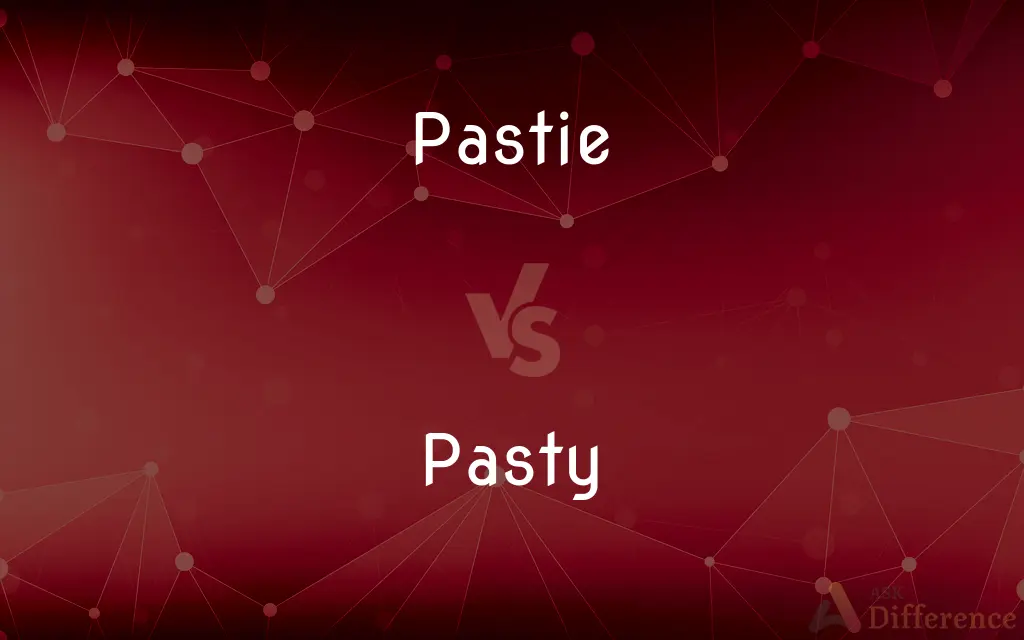Pastie vs. Pasty — What's the Difference?
By Tayyaba Rehman & Fiza Rafique — Updated on April 7, 2024
Pasties are savory pastry dishes, while pasty refers to a pale skin tone or a meat-filled pastry in some dialects.

Difference Between Pastie and Pasty
Table of Contents
ADVERTISEMENT
Key Differences
Pasties are a staple in British cuisine, known for their meat and vegetable fillings encased in a shortcrust pastry. They're traditionally associated with Cornwall and have a D-shaped, crimped edge. On the other hand, the term "pasty" can have two meanings. In one context, it refers to a pale, often unhealthy-looking complexion. In another, especially within certain English dialects, "pasty" can be synonymous with "pastie," referring to the same type of savory pastry.
Pasties are renowned for their portability and were historically a lunch for Cornish miners. They contain ingredients like beef, potatoes, swede (rutabaga), and onion. Pasty, when used to describe skin tone, doesn't share this culinary heritage. Instead, it denotes a lack of color or vibrancy in someone's appearance.
While pasties are celebrated for their hearty and comforting flavors, a "pasty" complexion is often viewed negatively, suggesting ill health or a need for more sunlight. In contrast, the culinary version of a pasty (akin to a pastie) is embraced for its rich, savory taste.
The preparation of pasties involves baking, where the filling cooks within the sealed pastry, creating a steamy, aromatic interior. This method is what gives pasties their distinctive texture and taste. However, achieving a "pasty" skin tone involves no such preparation and is typically used to describe someone's natural complexion or the result of limited sun exposure.
Pasties are subject to specific regulations, especially the Cornish pasty, which has Protected Geographical Indication (PGI) status in the EU. This means that only pasties made in Cornwall following traditional recipes can be called "Cornish pasties." The term "pasty," in its non-culinary usage, is not regulated and simply describes a skin tone.
ADVERTISEMENT
Comparison Chart
Definition
A savory pastry with meat and vegetable filling
A pale skin tone or, in dialect, a meat-filled pastry
Origin
British, especially Cornish
English (for the pastry); general English for complexion
Usage
Culinary
Descriptive for skin or culinary in dialects
Preparation
Baked with ingredients inside pastry
Not applicable for skin; baking for pastry
Perception
Regarded as a delicious meal
Negative for complexion; varies for pastry
Compare with Definitions
Pastie
A savory pastry filled with meat and vegetables.
She enjoyed a delicious Cornish pastie for lunch.
Pasty
Describing a pale, often unhealthy-looking skin tone.
After the long winter, her complexion was quite pasty.
Pastie
Can have a D-shaped, crimped edge.
The pastie's distinctive shape made it easy to eat on the go.
Pasty
A baked pastry dish in dialect usage.
The pasty was filled with savory pork and spices.
Pastie
Encased in a shortcrust pastry.
The pastie's flaky crust was perfectly golden.
Pasty
Lacking in color or vibrancy, when referring to complexion.
The illness left him looking unusually pasty.
Pastie
A traditional British meal, often associated with Cornwall.
Pasties are a staple in Cornish festivals.
Pasty
In some dialects, a synonym for pastie.
He ordered a beef pasty at the local bakery.
Pastie
A symbol of Cornish heritage.
The pastie is as much a part of Cornwall as its tin mines.
Pasty
A pasty () is a British baked pastry, a traditional variety of which is particularly associated with Cornwall, United Kingdom. It is made by placing an uncooked filling, typically meat and vegetables, on one half of a flat shortcrust pastry circle, folding the pastry in half to wrap the filling in a semicircle and crimping the curved edge to form a seal before baking.
Pastie
A pastie is a large to medium-sized battered deep-fried round of minced meat and vegetables common to Northern Ireland. Generally served with chips to form a "pastie supper" ("supper" in Northern Irish chip shops means something with chips), or in a white roll as a "pastie bap" or "pastie burger" it is a common staple in most fish and chip shops in the country.Recipes vary, but the most common ingredients are minced pork, onion, potato and seasoning formed into a "round" (just like a burger), which is then covered in a batter mix and deep fried.
Pasty
A folded pastry case with a savoury filling, typically of seasoned meat and vegetables.
Pastie
An item worn (often by strippers) to conceal one's nipples.
Pasty
(of a person's face) unhealthily pale
A pasty complexion
Pastie
A type of seasoned meat pie, usually of a semicircular or distinctive shape.
Pasty
Of or like paste
A pasty mixture
Pastie
(Northern Ireland) A circular, battered and deep-fried meat pie usually consisting of minced pork, onion, potato and seasoning and served in a bap or with chips. A peculiarity of Northern Irish "chippy" cuisine, rarely (if ever) seen outside the area.
Pasty
Resembling paste in consistency.
Pasty
Having a pale lifeless appearance; pallid
An unhealthy, pasty complexion.
Pasty
A pie or turnover, especially one with a savory filling including seasoned meat, fish, or vegetables.
Pasty
Like paste, sticky.
These mashed potatoes aren’t cooked well; they are very pasty.
Pasty
Pale, lacking colour, having a pallor
He is pasty-faced.
Are you feeling OK? You look a bit pasty.
Pasty
White-skinned
Pasty
A small item of clothing that conceals little more than the nipple of a woman's breast, primarily worn by female exotic dancers.
Pasty
A type of seasoned meat and vegetable hand pie, usually of a semicircular shape.
Pasty
Like paste, as in color, softness, stickness.
Pasty
A pie consisting usually of meat wholly surrounded with a crust made of a sheet of paste, and often baked without a dish; a meat pie.
A large pasty baked in a pewter platter.
Pasty
Small meat pie or turnover
Pasty
Resembling paste in color; pallid;
The looked pasty and red-eyed
A complexion that had been pastelike was now chalky white
Pasty
Having the properties of glue
Common Curiosities
What does pasty mean?
Pasty can refer to a pale skin tone or, in some English dialects, a meat-filled pastry similar to a pastie.
What is a pastie?
A pastie is a savory pastry dish filled with meat and vegetables, originating from Britain.
Can only pasties from Cornwall be called Cornish pasties?
Yes, only pasties made in Cornwall following traditional recipes can legally be called Cornish pasties, especially in regions recognizing PGI status.
Are pasties the same as pasties in all contexts?
Not always. While "pastie" specifically refers to a type of savory pastry, "pasty" can either describe a pale complexion or the same type of pastry, depending on the context.
What ingredients are typically found in a pastie?
Traditional pasties are filled with beef, potato, swede (rutabaga), and onion, all encased in a shortcrust pastry.
What is the significance of the crimped edge on a pastie?
The crimped edge serves a practical purpose, sealing the filling inside the pastry. Historically, it also allowed miners to hold the pastie by the edge, which they could discard to avoid ingesting toxic substances on their hands.
Is the term "pasty" ever used positively?
When referring to complexion, it's generally used negatively. However, when used as a synonym for pastie in certain dialects, it can have a positive, culinary connotation.
How is a pastie cooked?
A pastie is baked, with the raw ingredients placed inside the pastry. The baking process cooks the filling and browns the pastry.
Is there a difference in the nutritional value between a pastie and its culinary equivalent referred to as "pasty" in some dialects?
No, when "pasty" refers to the same type of savory pastry as "pastie," there is no nutritional difference; the variation lies solely in terminology.
How did pasties become associated with Cornwall?
Pasties have a long history in Cornwall, serving as a hearty meal for miners. Their popularity and association with the region grew over time, especially since they are a convenient and filling meal for workers.
Are pasties eaten hot or cold?
Pasties can be enjoyed both hot and cold, making them a versatile meal option for various occasions.
Why do some people refer to pasties as pasties?
This variation is often due to regional dialects or pronunciation differences, where "pasty" is used interchangeably with "pastie" to refer to the same savory pastry.
Can vegetarians eat pasties?
Yes, there are vegetarian versions of pasties available that substitute the meat with additional vegetables or meat alternatives.
What does it mean if someone is described as having a pasty complexion?
It means their skin tone is pale and lacking in color, sometimes implying poor health or insufficient sunlight exposure.
What are the legal protections for Cornish pasties?
Cornish pasties have Protected Geographical Indication (PGI) status within the European Union, meaning they must be made in Cornwall and adhere to a specific recipe to be called "Cornish pasties." This protects their heritage and ensures quality control.
Share Your Discovery

Previous Comparison
Miss vs. Madam
Next Comparison
Keffiyeh vs. ShemaghAuthor Spotlight
Written by
Tayyaba RehmanTayyaba Rehman is a distinguished writer, currently serving as a primary contributor to askdifference.com. As a researcher in semantics and etymology, Tayyaba's passion for the complexity of languages and their distinctions has found a perfect home on the platform. Tayyaba delves into the intricacies of language, distinguishing between commonly confused words and phrases, thereby providing clarity for readers worldwide.
Co-written by
Fiza RafiqueFiza Rafique is a skilled content writer at AskDifference.com, where she meticulously refines and enhances written pieces. Drawing from her vast editorial expertise, Fiza ensures clarity, accuracy, and precision in every article. Passionate about language, she continually seeks to elevate the quality of content for readers worldwide.















































